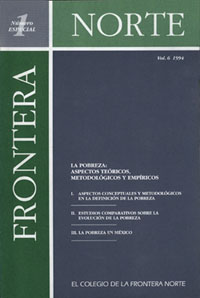A Poverty Profile of Mexico in 1989
Main Article Content
Abstract
Article Details
Authors publishing work in this journal agree to the following conditions:
Authors retain copyright and assign first publication rights to the journal Frontera Norte (RFN), with the texts registered under an Attribution-NonCommercial-NoDerivatives 4.0 International Creative Commons license (CC BY-NC-ND 4.0), which allows third parties to use published material provided they give credit to the authors and acknowledge this journal as the first publisher.
They authorize the reproduction, publication, translation, communication, and transmission of their paper and all accompanying material, publicly and in any form and by any means; its public distribution in as many copies as required; and public communication thereof in any form, including making it available to the public through electronic means or any other technology, and solely for dissemination and scientific, cultural, and non-commercial purposes.
Authors may enter into further independent contractual agreements for the non-exclusive distribution of the version of the paper published in this journal (for instance, to include it in an institutional repository or personal webpage, or publish it in a book), provided it is not for commercial purposes and they clearly state that the work was first published in Frontera Norte (RFN) [and add the corresponding bibliographical record: Author/s (Year). Title of paper. Frontera Norte, volume (number), pp. doi: xxxx].
To that end, authors must submit the form assigning ownership of first publication rights, duly completed and signed. This document is to be uploaded in PDF format as a complementary file on the OJS platform.
This work is released under an Attribution-NonCommercial-NoDerivatives 4.0 International Creative Commons license (CC BY-NC-ND 4.0)..
References
See Santiago Levy, Poverty Alleviation in Mexico, Working Paper Series, no. 679 (Washington, D.C.: The World Bank, 1991).
For further details, see Diana Alarcón, "Changes in the Distribution of Income in Mexico during the Period of Trade Liberalization," Ph.D. dissertation, University of California, Riverside, December 1993.
Levy also made estimates of poverty based on constructing a line of moderate poverty. The construction of the consumption basket used to define moderate poverty was based on the pattern of consumption of the seventh decile, but it includes several other consumption goods considered essential components of a minimum standard of living. Not surprisingly, over 70 percent of the population have usually been classified as poor when such a methodology is used. The methodology used to construct the consumption basket for moderate poverty can be found in: COPLAMAR, Macroeconomía de las necesidades esenciales en Mexico: situación actual y perspectivas al año 2000, 2d. ed. (Mexico: Siglo XXI, 1989): Appendix II.
All of the above percentages are based on the whole sample of 11 525 households, which are weighted in order to represent the underlying population. Our results based on weighted data usually differ only marginally from those based on unweighted data, which we used initially in order to compare our results to those of the Levy study.
In much of the analysis in this section and others, we analyze the characteristics of the head of household. As is well known, this is not a completely reliable indicator of the condition of the whole household. We hope in the future to supplement our current findings with an analysis of all household members.
All expenditure and income statistics for 1989 are reported in old pesos. In order to convert to new pesos, divide all figures by 1000.
Regression analysis bears out this relationship between the age of the household head and per capita household income for the Mexican population as a whole.
For an elucidation of this methodology, see Lionel Demery, "The Poverty Profile," in Understanding the Social effects of Policy Reform, ed. Lionel Demery, Marco Ferroni, and Christiaan Grootaert (Washington, D.C.: The World Bank, 1993).
For an early application of this concept, see Sudhir Anand, Inequality and Poverty in Malaysia (Washington, D.C.: Oxford University Press, for the World Bank, 1983).
This percentage is equal to 1 minus the income gap ratio.
See Martin Ravallion, Poverty Comparisons: A Guide to Concepts and Methods, Living Standards Measurement Study, Working Paper No. 88 (Washington, D.C.: The World Bank, 1992).
The 1989 Income-Expenditure Survey does not strictly differentiate between rural and urban areas; it differentiates between what it calls "high-density areas" and "low-density areas." For an explanation of this distinction, see INEGI, Encuesta Nacional de Ingreso-Gasto de los Hogares 1989 (México; INEGI, 1992).
For an illustration of the use of this methodology, see a recent publication: Azizur Rahman Khan, Keith Griffin, Carl Riskin, and Zhao Renwei, "Household Income and Its Distribution in China," in The Distribution of Income in China, ed. Keith Griffin and Zhao Renwei (New York: St. Martin's Press, 1993).
Income from cooperatives is the component most prevalent among the poorest of the poor, with a negative concentration ratio, but it is an insignificant proportion of the poor's total income.

